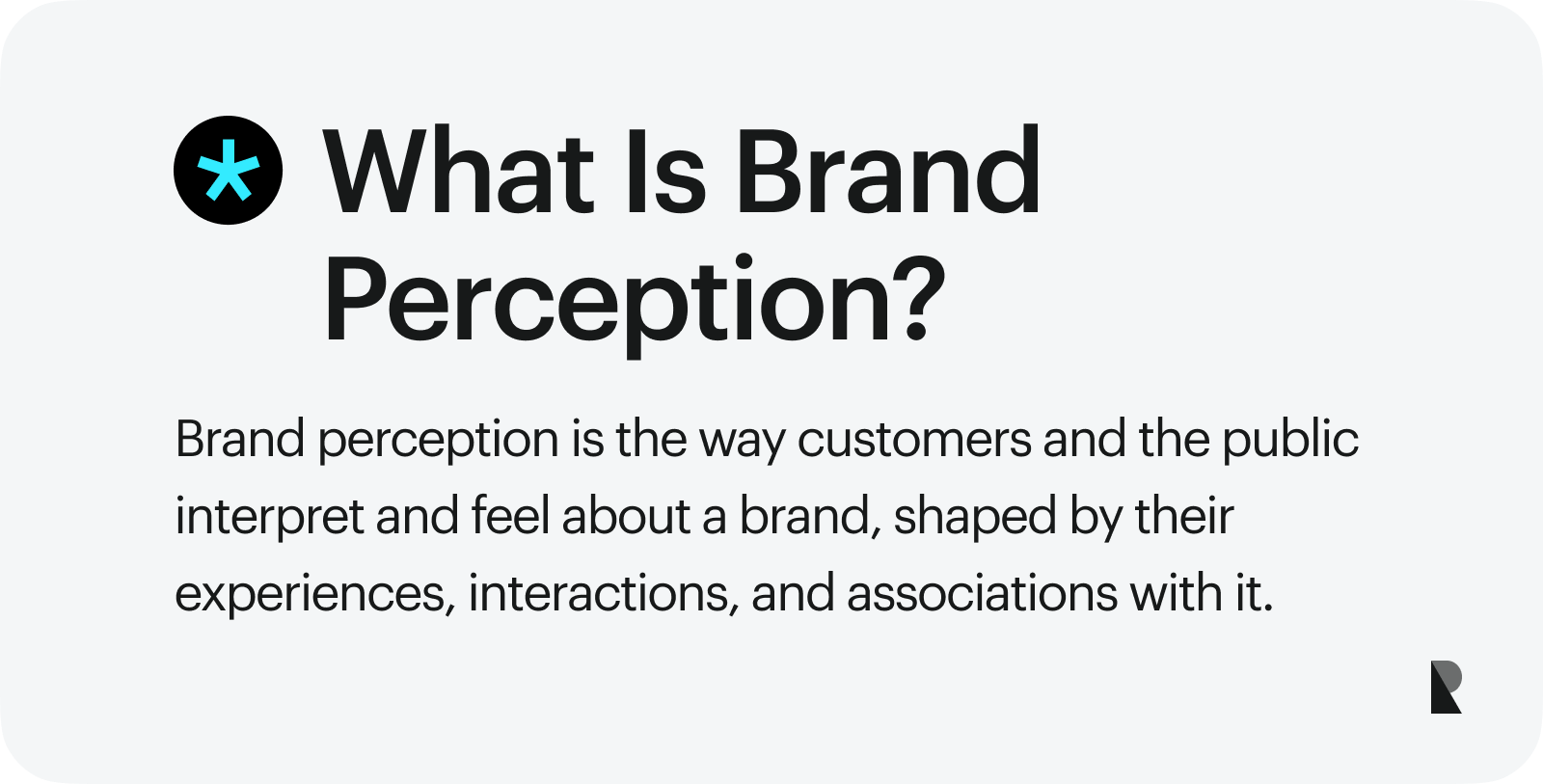
Do you know that if your customers believe in your brand, they are likelier to buy from you? According to recent studies, trust and positive opinions about the company are crucial in decision-making. Almost 80% of respondents say that they would return and even recommend the brand to a friend after having a positive experience with a company.
Indeed, the brand's perception matters. It has become crucial for the successful development of modern business lately. Though, no surprises here. As a vital part of brand equity, it affects many aspects of the decision-making process and general attitude toward the company. In some cases, it can even be a tiebreaker.
The good news is it is not hard to understand brand perception. Dive into our guide that reveals its essentials, uncovers popular approaches for measuring it, and shows how industry leaders effectively fight competition using it.
Brand Perception Definition
Brand perception is a mental association that, according to every professional brand design agency, is crucial for a company's successful existence in the market. Let us define its meaning to get a grasp of it.
It accumulates everything concerning the brand's presence and product's value in the market and World. Whatever step you take, whatever mistake you make, the brand perception will react to it and either improve and grow or suffer consequences and lose its position and potential. Therefore, it is correct to refer to it as consumer brand perception.
Core Elements of Brand Perception
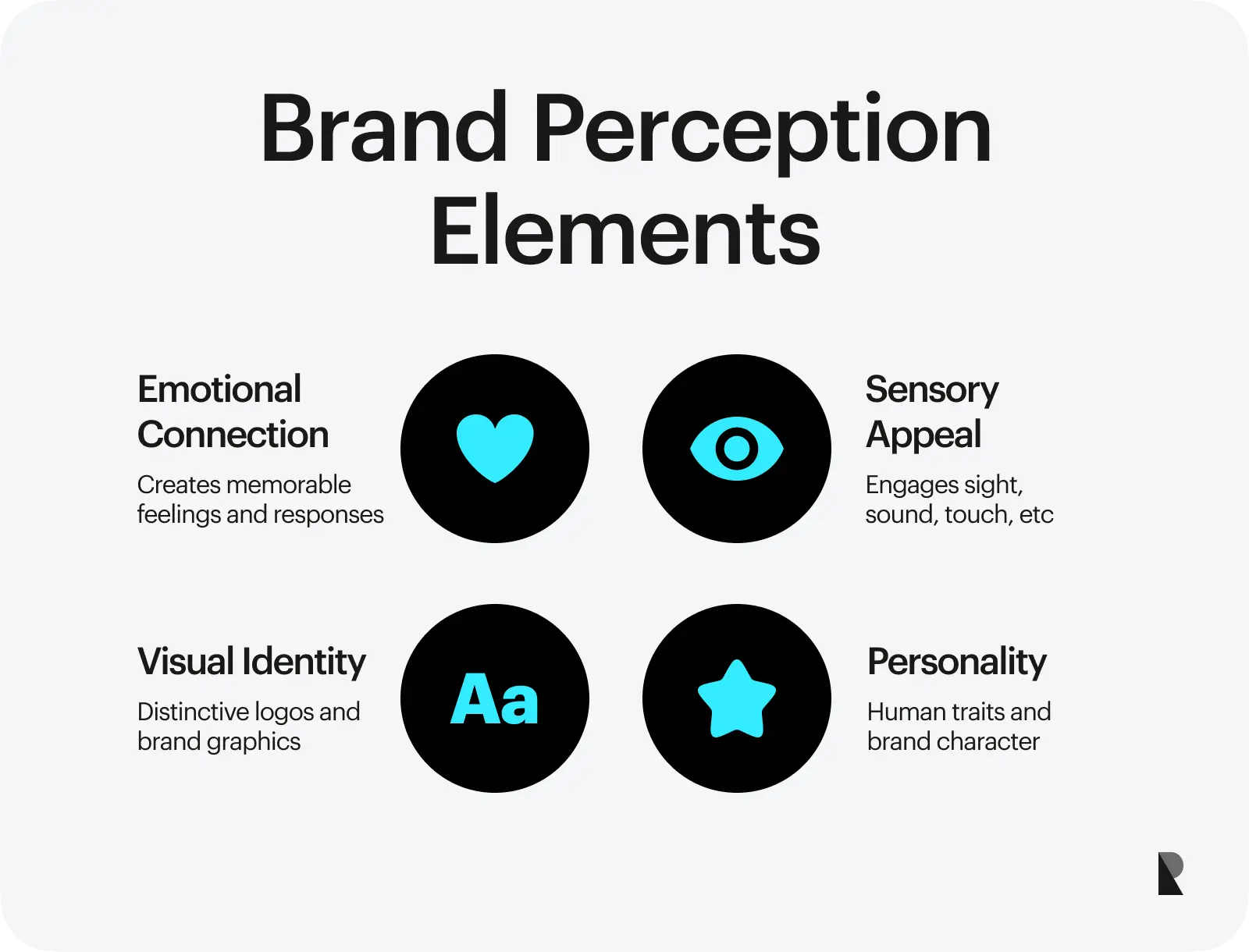
Although companies do not own their perceptions, they still have the power to influence them by sending messages, running nurturing campaigns, and making serious marketing efforts. To understand how they can do this, it is crucial to determine the core elements of brand identity, which influence customer perception. They are:
- Emotional connection. Heartstring-tugging advertisements and marketing campaigns that cultivate specific emotional responses.
- Visual identity. Logo, mascot, illustrations, and graphics that are directly linked to the brand's identity.
- Personality. This involves traits that elicit a particular emotional response in users, represent the company's charisma, intentions, and even mission, and humanizes the brand, thereby making it closer and friendlier to the audience.
- Senses. Taste, touch, hearing, smell, and sight - each one can be used as a "door" to the consumer's heart. Not every company can use them due to niche limitations. However, if it finds a way to activate at least one of them, it will certainly win extra points. Just recall catchy musical jingles (like Coca-Cola Christmas song) or catchphrases (like McDonald's "I'm loving it"), and you will understand its power.
Each this aspect drastically influences brand perception. When a company succeeds in connecting its brand personality to crucial customers' senses (including emotions), it easily resonates with the audience on a visceral level, thereby creating a deep bond and long-lasting mental impression.
The Importance of Brand Perception
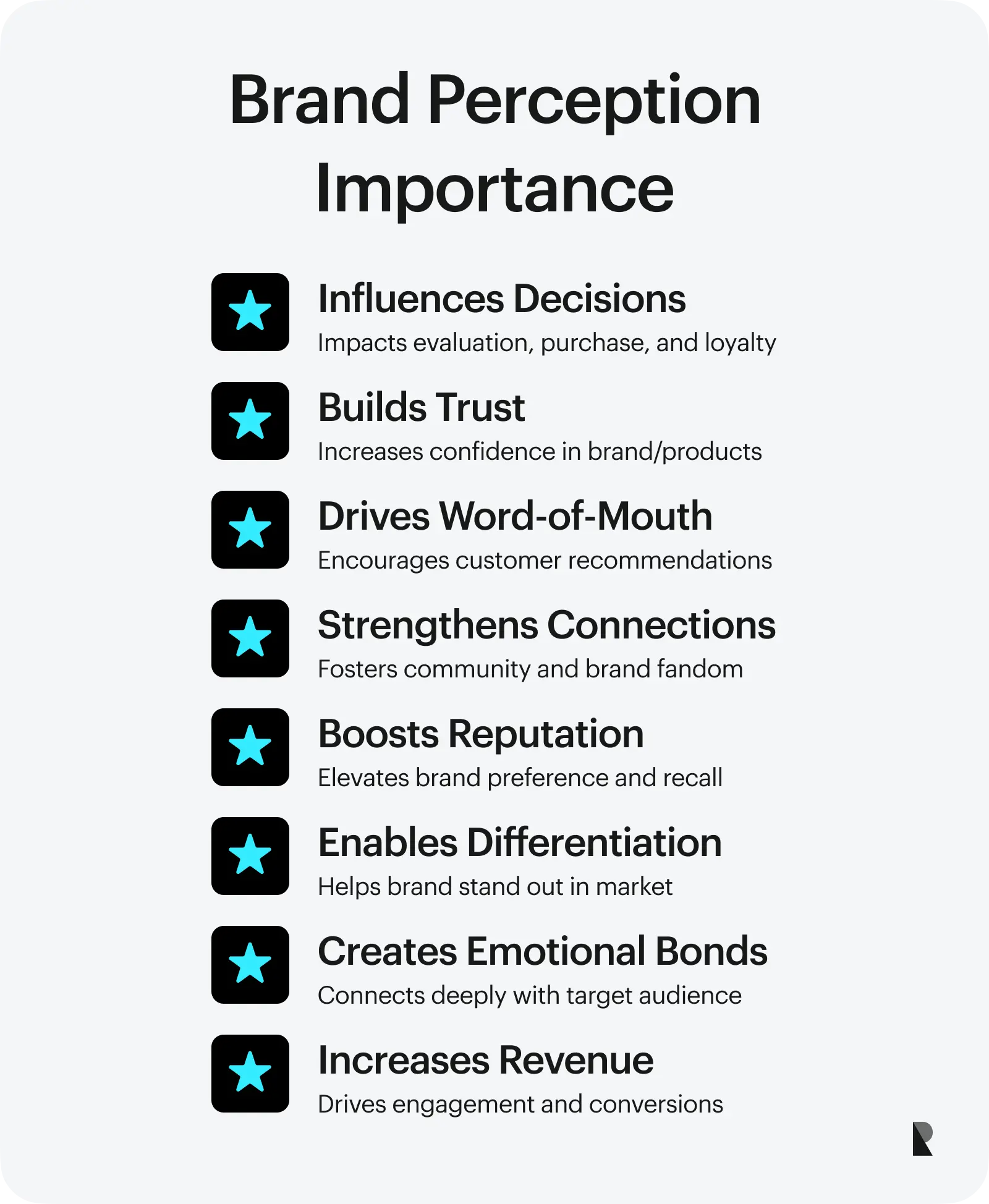
The consumer decision-making process involves five primary stages, which start with problem recognition and end with post-purchase evaluation. Nothing is done on a whim. Specific arguments inspire and compel users to choose a company over others. It is here where the importance of brand perception becomes evident.
There is more. There are other good reasons why brand perception matters for successful brand development.
- It makes customers believe in your company and the products sold under its name. This instills more confidence in purchasing from you regardless of the price policy or fluctuations in the market.
- It encourages customers to recommend your services to others. This kind of word-of-mouth marketing helps brands cut through all the noise in the market oversaturated with messages.
- It helps to build the proper connection with the target audience and create buzz, a community, and fandom.
- It turns a regular brand into the favorite one. Being loved and preferable by customers means a lot. First, it strengthens the company's reputation. Second, it brings in new customers to your business. Third, it increases the lifetime value of consumers.
- It helps buyers identify and recall a brand in a distinct position. With an oversaturated market where brands in niches are baked like hot pancakes, this quality is of massive importance for survival.
- It influences assortments.
- It creates emotional connections between the company and the target audience.
- It directly affects the bottom line by driving engagement, generating conversions, and raising revenue.
Focusing on brand perception and reinforcing it along the way are highly recommended by brand specialists to achieve success in the company's development.
Advantages of Strong Positive Brand Perception
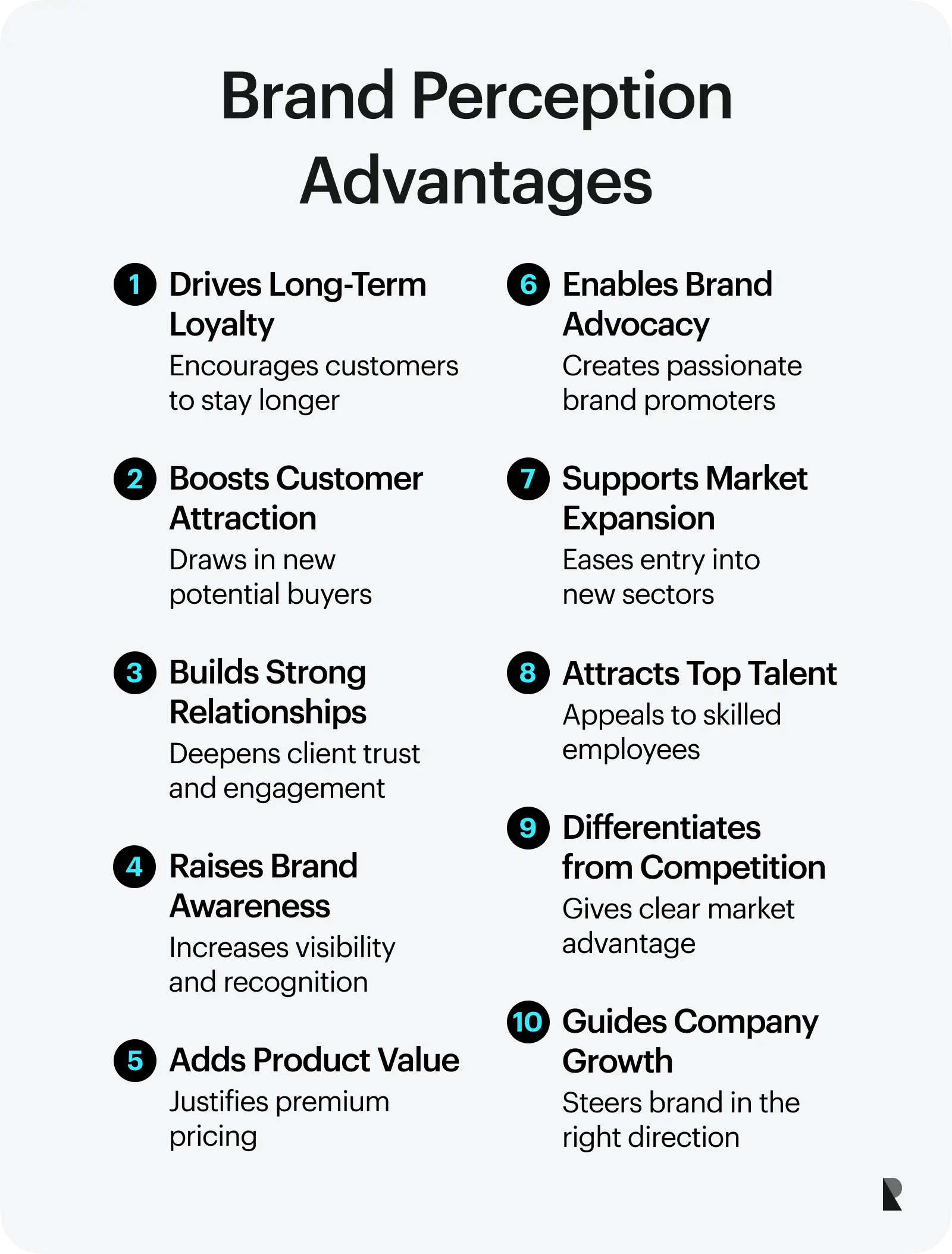
Brand perception is an intangible asset, but it brings tangible benefits to the company when it is positive, strong, and healthy. Consider things it can do when putting in marketing, branding, and advertising campaigns.
- It gives customers a reason to stay with your business long-term.
- It increases customer loyalty.
- It offer opportunities to attract customers.
- It builds strong relationships with clients.
- It raises brand awareness.
- It adds extra value to products.
- It makes customers feel a certain way.
- It stands behind a higher market share.
- It builds chances of creating brand advocates.
- It allows for moving into the premium sector and changing pricing policies.
- It develops strong brand equity and identity.
- It helps to conquer new niches and sectors in the market.
- It has an impact on your employee growth by attracting talents and specialists.
- It separates the company from the competition and gives a huge advantage over others.
Last but not least, brand perception sets the company on the proper trajectory and helps it navigate multiple obstacles.
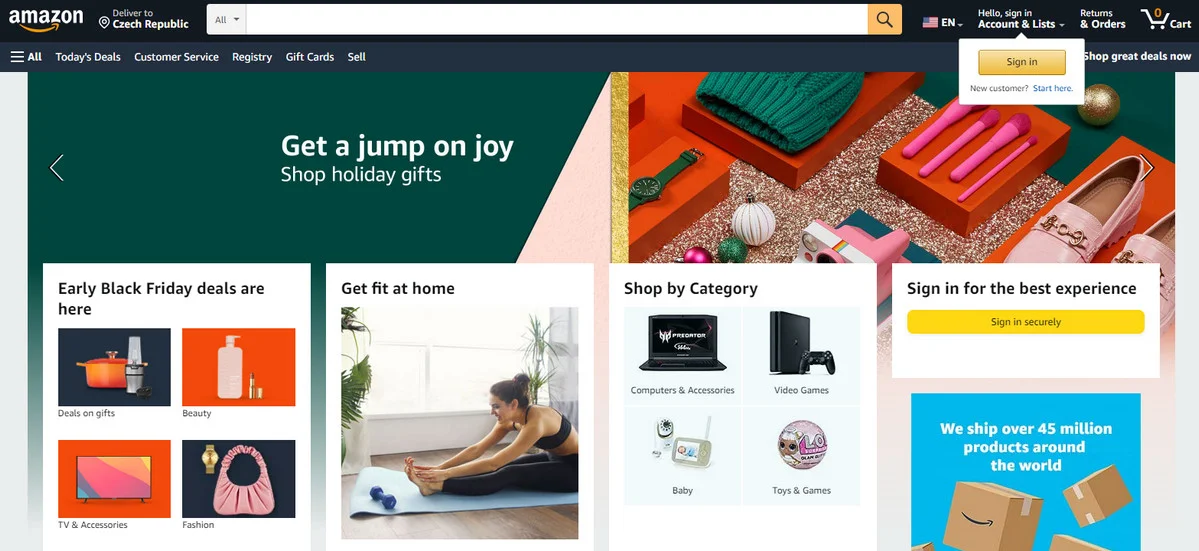
Amazon sees huge growth due to its strong brand perception.
Consequences of Negative Brand Perception
Do you know that almost 50% of all businesses in the World, regardless of niche, target audience, and budget fail after being open for five years? The analysts agree that one of the main reasons for that is that their reputation and, ipso facto, band perception were not correctly handled.
Indeed, poor or negative perception may have drastic consequences for your business and substantial repercussions among existing customers and potential ones. For example, if something is wrong, it is more likely your clients will stop shopping at your company and tell potential customers about a negative experience.
At a minimum, this will increase bounce rate and decrease conversion rates and ipso facto revenue. It will also reduce the number of new customers. At maximum, it may ruin the brand's reputation, drastically lower its position in the market and kill loyal customers' trust.
So, what to do? To minify and even eliminate these consequences, it is crucial to avoid these causes:
- Being constantly short on time when it comes to branding.
- Not meeting industry standards with customer service.
- Prefer customer experience in-store to the one in the web platform.
- Taking the importance of SEO practices lightly.
- Experiencing a shortage of professional staff.
- Not investing in various facets of business, such as email or advertising campaigns.
- Not simplifying and automating processes that may improve task management and elevate staff productivity.
- Not innovating brand strategy.
- Not equipping yourself with new technologies.
- Using lousy partners like low-quality hosting provider that constantly experiences downtime.
- Ignoring poor web platform performance.
- Not knowing branding essentials and its best practices.
- Not educating employees about the branding process, company's guidelines, mission, vision, and goals.
- Abstracting from trends, tendencies, and mainstreams.
How to Reinforce Positive Brand Perception?
Avoiding the causes listed above is not enough to build a positive brand image. It is also crucial to follow the best practices and adopt techniques proven by specialists. Consider these tips:
- Always pay attention to how your customers perceive your business. If there are some issues, immediately address them. Apologize and make amends.
- Invest in excellent customer service.
- Enforce brand protection strategy.
- Reach your brand's target audience within well-established or professional communities.
- Spot counterfeit products and remove them from the market.
- Detect and avoid grey markets.
- Create touchpoints for customer engagement.
- Gather and use only relevant market data.
- Use trusted platforms to maximize the organic brand's social presence.
- Improve SEO with user-intent-related keywords.
- Develop a brand voice.
- Stay consistent across multiple distribution channels.
- Create healthy working culture.
- Add value to your consumers' lives through alternative and trendy approaches, like creating a podcast, running radio programs, or sharing helpful video tutorials.
- Employ native advertising.
- Partner with influencers.
- Run appreciation and nurturing campaigns.
- Define factors that influence brand perception to monitor them regularly.
- Grab any opportunity to improve brand perception.
- Last but not least. Measure the company's brand perception regularly.
How to Measure Overall Brand Perception?
Believe it or not, the reality of public opinion is constantly overestimated by brands. Most entrepreneurs are over-confident and too enthusiastic about their brand equity, feeling like they understand what their brand represents and how their target audience considers them in the market. However, as practice shows, they are seriously wrong.
The main reason is that brand perception is owned by customers, not companies. Whatever message you send, whatever platforms or tools you use, whatever good you look tonight, customers have the final word. Brand image is formed over time through different client experiences.
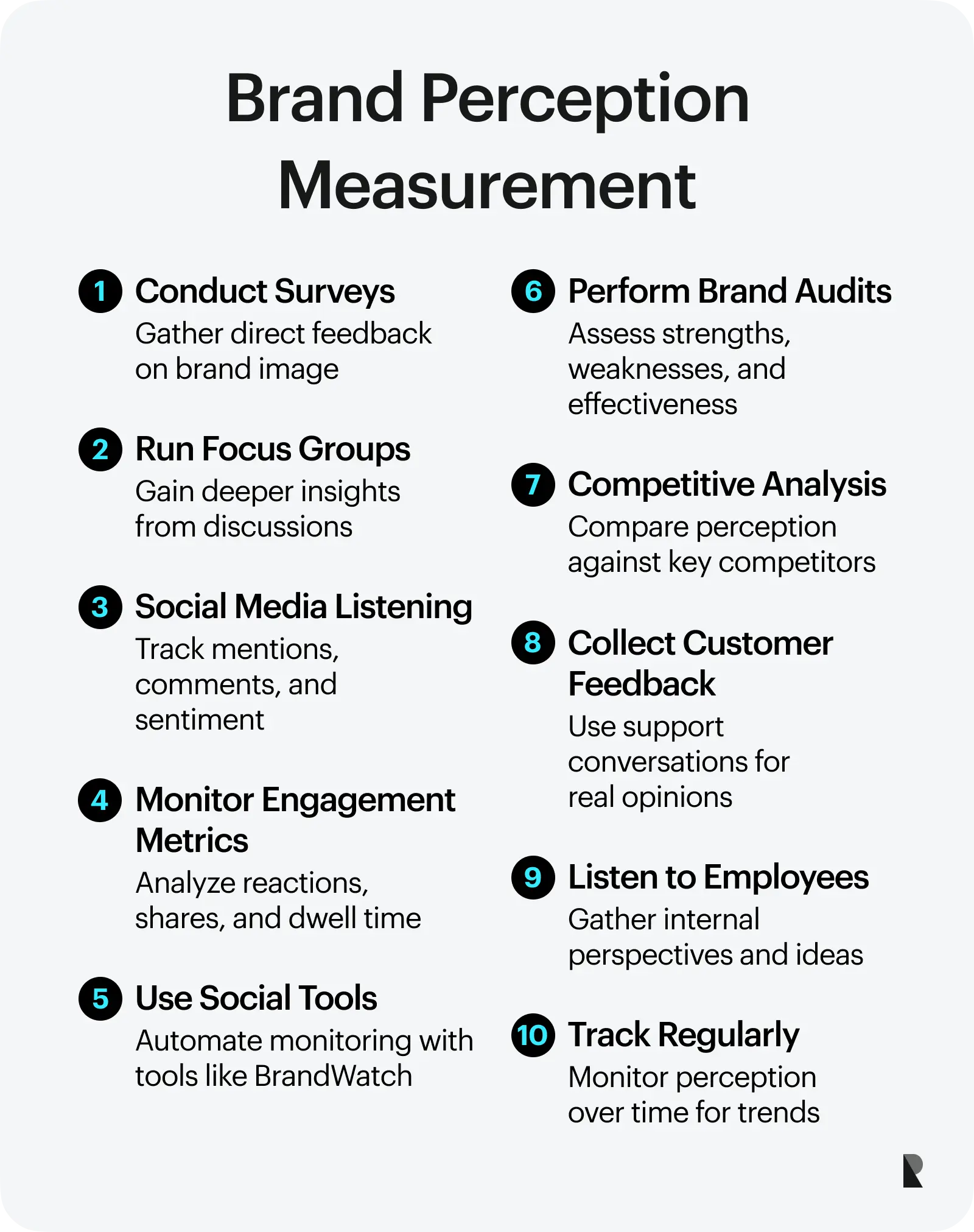
Therefore, measuring brand perception instead of jumping to conclusions based on the company's prism of view is crucial. This helps avoid delusions, misinterpretations, wrong understanding of the target audience and overall market attitude towards the company.
Despite the fact that brand perception is an intangible asset that embraces numerous factors like a company's reputation, user experience, feedback, functionality, advertising, and social media engagement, it is possible to gather real metrics and correctly estimate the brand's presence. How to do this? Let us consider several time-proven ways.
Conduct Regular Surveys
There is no better way to find out how the target audience perceives your brand than to ask about it. It is the simplest and most cost-effective method that can be conducted everywhere: social media platforms, web and mobile applications, and in-store. It is also increasingly flexible and adaptive to the target audience's current needs since stakeholders may finish it on their own time.
When well-done, surveys allow painting a picture of the mental real estate your brand owns. It also gives insights into how it compares to your competitors' brands. To make it effective, it is vital to focus on four key areas: cognitive, emotional, language and action.
- Questions in the cognitive area should draw out consumers' associations with your brand.
- Questions in the emotional area should identify the feelings related to your brand.
- Questions in the language area should reveal how consumers perceive and describe your brand.
- Questions to action areas should determine the user experience and its positive or negative effect on them.
Think through these questions because they may help to
- define whether you have great customer service or not;
- determine weaknesses, strengths, and areas for improvement;
- understand how well marketing and branding campaigns resonate with the audience;
- bridge the gap between the brand and product's fundamental qualities and how the customer feels.
Along with that, conduct brand focus groups: they also bring a wealth of helpful insights and data.
Social Media Monitoring and Listening
While the previous approach is a little outdated, yet it still works quite effectively, this one is turn-of-the-century, and it has already proved its validity. It opens the door to the performance of social media campaigns and efforts and provides entrepreneurs with an opportunity to understand the brand's perception better.
Social listening involves several activities that can be done across popular social platforms. They are
- tracking reactions to your brand;
- determining the type of content that resonates the best by getting the most views or the one that fails by getting bad reviews;
- inspecting social media interactions;
- estimating the number of shout-outs of your brand;
- defining dwell time;
- monitoring, reading, and deriving insights from comments, reviews, and relevant hashtags.
The best part is this approach can be automated. Many professional tools do all the heavy lifting: Google alerts, BrandWatch, and Sprinklr, to name a few. Use social media listening to get real insights into the performance of your brand's multiple campaigns.
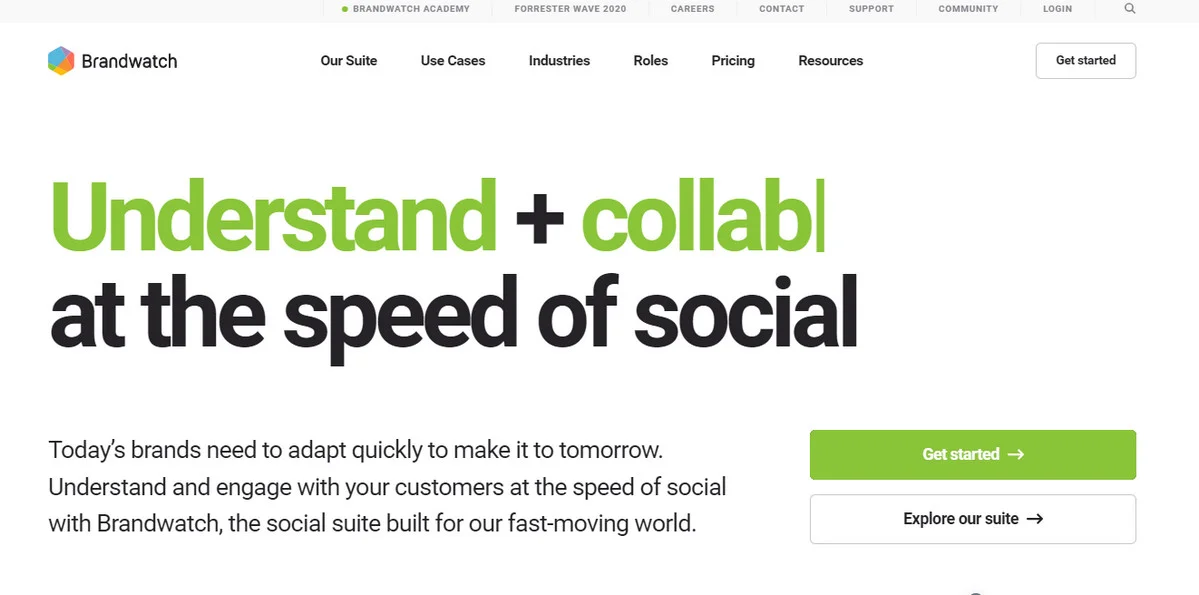
Brandwatch – Popular social listening tool
Do Brand Audit
Much like conducting surveys, doing a regular brand audit is also an oldie-but-goodie practice that works and, most importantly, brings a wealth of valuable data. Coming in all shapes and sizes, it investigates all the brand's factors and activities to ascertain how well your customers think your brand is doing and how well it performs across the boards. In general, it does this:
- do competitive analysis;
- uncover hidden roadblocks;
- identify brand advocates;
- do brand perception research on the primary target audience;
- explore the secondary market sector to define segments with prospective customers;
- evaluate brand perception strategies;
- demonstrate the performance and effectiveness of marketing, branding, and advertising efforts;
- inspect the brand's perception and positioning.
It covers three main areas: internal branding, external branding, and customer experience. The last two bring data on how to change things to improve brand perception.
Last but not least
As we have mentioned once or twice, consumers have 'ownership' over the brand's perception. The situation can drastically change due to various companies' activities, and the company may not even know that. Therefore, it is crucial to measure this aspect regularly, track it during a certain period, and identify what drags the company back.
On top of that, it is highly advisable to follow these time-proven practices:
- Be realistic and take an honest look at your brand.
- Do not be afraid to refresh your brand's presence or adopt new ways to improve it.
- Regularly send out customer feedback and conduct brand perception surveys. Process them and derive the most crucial data.
- Prime your support team to have genuine conversations with customers.
- Consider everyone's opinions. Listen to your audience and ask your employees.
- Stay consistent with brand messaging.
- Monitor brand perception regularly.
- Always look for opportunities to improve and meet the target audience's current needs and expectations.
Great Brand Perception Examples
From theory to practice, let us consider five fantastic examples of powerful brand perception.
1. Coca-Cola
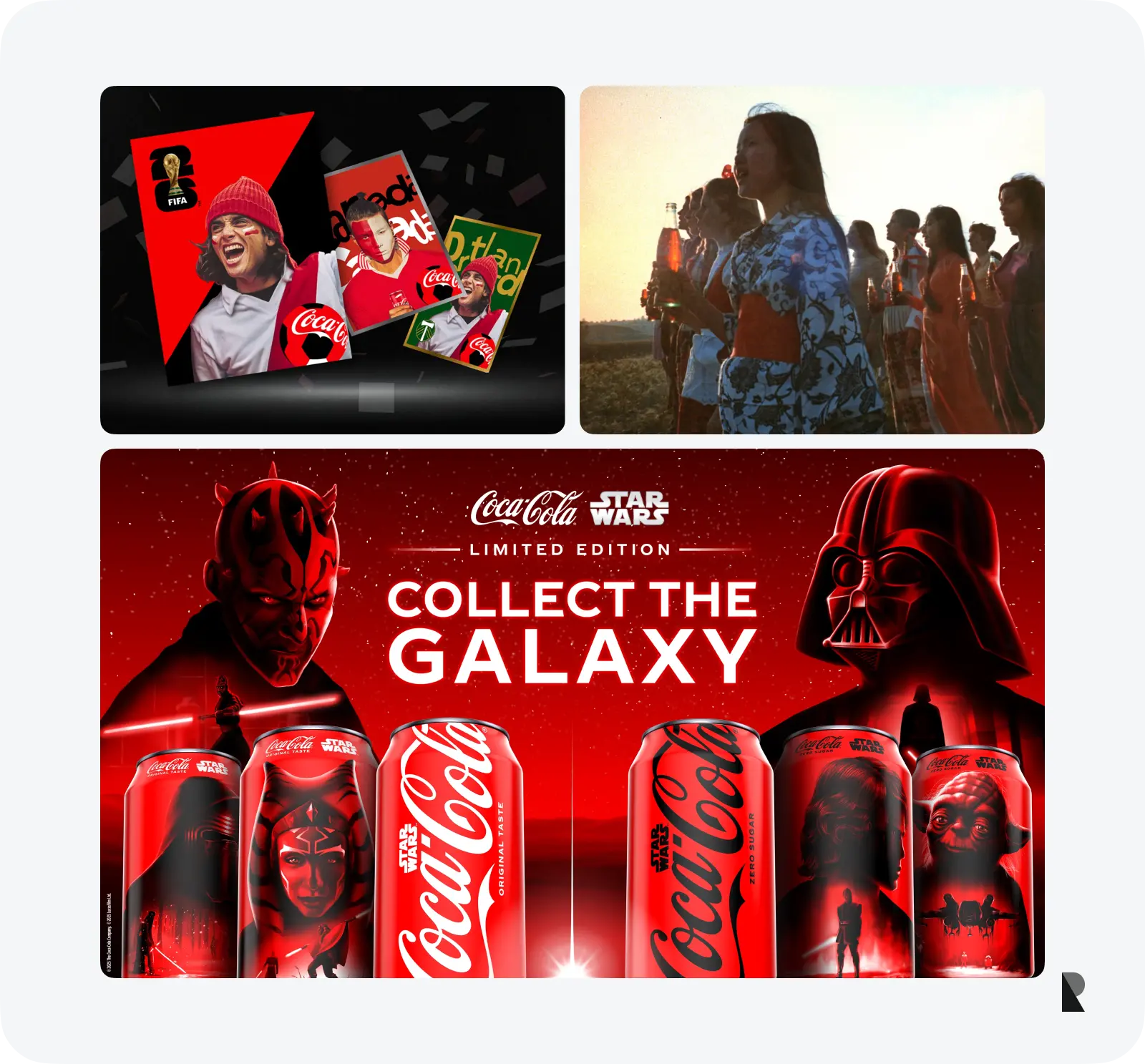
First on our list is Coca-Cola. I bet you have heard it once or twice. Even kids know what it is – this is a sign of the brand's perception done right.
This one-hundred-year brand spends loads of money on its products and the brand's identity, equity, and perception. For decades, it has been following trends, listening to the audience, delivering the right messages to the right crowd, and improving its presence. As a result, today, it enjoys vast revenues and occupies a strong position in the market, being synonymous with its niche, even despite functioning in a cut-throat segment.
2. McDonald's

This is another brand on our list that does not need any introduction. It goes hand in hand with the previous brand bringing some positive associations in consumers' minds, demonstrating a bright example of a professional co-branded partnership.
McDonald's brand perception is increasingly strong and positive. However, it was not always that way. America's beloved fast-food chain has been involved in numerous scandals.
Nevertheless, despite fiascos, the team managed to regain its position and even take the corporation to the next level by providing excellent user experience, constantly fulfilling its promise, addressing issues without compromises, improving the brand's position, and adopting the best practices.
McDonald's is proof that the constantly nurtured brand perception impacts the overall brand image and allows the company to reclaim its position and move forward despite failures.
3. Mercedes

The German car brand Mercedes is synonymous with perfection, excellence, and luxury quality. It has a rich history filled with ups and downs. Established in 1926, it managed to survive World War II and go from dull to premium, maintaining its market position for decades.
The key to its success lies in maintaining its core values of quality, safety, and luxurious user experience no matter what. Even now, in the era of electric cars, they have successfully embraced modern trends, meeting the growing demands of the market yet staying true to their roots.
Regarding brand equity and perception, Mercedes constantly improves them by delivering the quality they promise and conducting campaigns to support its brand image. On top of that, they regularly push themselves further to reach new goals and offer new exclusive options to sustain their superior status.
4. Chanel

Chanel is one of the leading luxury fashion houses in the World. Founded in Paris in 1910 by Coco Chanel, it began its story as a hat maker. However, after several years its image started to become associated with ready-to-wear, luxury goods, and accessories because it strived to meet the needs of its fashion-obsessed audience.
During its history, the famous French fashion house has been a trendsetter and attentive listener. It has been smart with social interactions and making mainstreams work for them as well. For instance, they have constantly invested in celebrity faces. Catherine Deneuve, Marilyn Monroe, Claudia Schiffer, Kate Moss, Nicole Kidman, and Brad Pitt have been brand ambassadors. They have sent a proper message to the crowd, building trust, increasing loyalty, and reinforcing positive brand perception. As a result, these days, Chanel has a savvy, professional, luxurious, and current impression in the minds of the market.
5. Google

Google is one of the most important and influential brands that has dramatically changed our lifestyle. Unlike the brands featured above, it is relatively young – only 24 years old. However, it has already carved a niche for itself.
Google's path to success has not been without roadblocks and fiascos. We have recently witnessed a scandal around its social media platform, whereas privacy scandals have been a constant in Google's history. Nevertheless, it still stands tall, cementing its position every single year.
Its secret lies in fulfilling its promises and constantly pushing forward. Whatever happens, we know we can "google" it and find answers to our questions. For entrepreneurs, Google is a crucial asset that opens enormous opportunities for growth and expansion and provides insights about their web platform's performance through analytical and tracking tools.
Google's brand perception is not ideal. It is constantly questioned. Nevertheless, the team works on it regularly. They strive to bring the best user experience and keep satisfaction with the product at a high level by improving service, listening to the audience, addressing the issues, and regularly reinforcing their presence and position. As a result, Google is the number one search engine in the World.
Conclusion
Brand perception is an intangible yet crucial asset of a company's market presence. It directly influences the decision-making process, encourages positive word-of-mouth, and affects the bottom line by generating fans and increasing revenue. As an integral part of a brand's equity, it is widely considered a shortcut to success.
As befits, with such great potential, it is not easy to handle. The biggest obstacle companies stumble upon is that they do not own it. Consumers possess it. Therefore, they can easily make or break it. However, businesses still have an opportunity to influence and build it from outside. Follow the best practices, and always keep an eye on the metrics like industry leaders do to ensure your brand's perception is healthy and strong.
Nov 29, 2022
